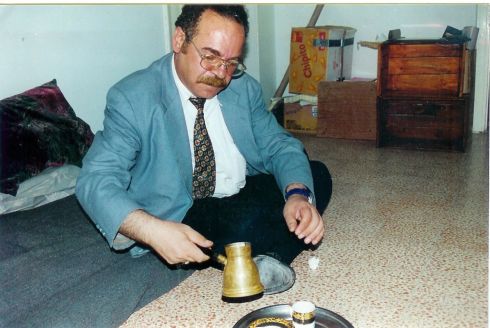My phone rang. It was six in the morning in Chicago. Who would call at that hour? As my answering machine picked up the call I struggled to wake up, figure out where I was, place the voice. It was Hussein. Just as I was able to open my eyes, Hussein’s message ended and the link with the other side of the world was broken.
I first met Hussein in a restaurant off of Abdali bus station where he was playing violin. An Arab woman can’t talk to strange men, only her brothers and her fiance, but as a westerner I didn’t care about that. I was curious and I talked to everyone. The important thing is not to be alone with a strange man because it looks bad and people will talk. So Hussein and I met in public–at an artists’ gallery where he drew portraits and gave lessons on the oud (an Arab lute), at coffeeshops where he played violin, at the remains of a Byzantine church on the same hill where I lived. All of these places had Turkish coffee, and Hussein was very much in demand to read the coffee grounds because he had a reputation for being close to Allah.
 Once, my friend from Tafila, another American, was in town. Since I had a chaperone to make things proper, I could invite Hussein to my apartment. In the first photo Hussein is in my living room in my apartment at the southern tip of Jebel al-Webdeh. Note the plush decor. He is showing us how to make the coffee.
Once, my friend from Tafila, another American, was in town. Since I had a chaperone to make things proper, I could invite Hussein to my apartment. In the first photo Hussein is in my living room in my apartment at the southern tip of Jebel al-Webdeh. Note the plush decor. He is showing us how to make the coffee.
First, water goes into a special little long-handled pot for boiling coffee. Then, a large spoon of coffee powder and an equally large spoon of sugar are stirred into the water. It is brought to a boil, then heated over the flame for 3 or 4 minutes, stirring constantly and occasionally removing it from the flame to keep it from boiling over . (My propane ghaz was a really fancy one. Besides the ususal two large burners, it had an extra tiny burner for heating coffee.) Then the coffee is brought to where it will be consumed and allowed to sit until it is cool enough to drink. Most of the sludge also settles to the bottom. The coffee goes into a finjon (small coffee cup). Pour carefully, so as not to disturb the sludge, then enjoy.
My last week in the Middle East was spend saying goodby to friends. I found Hussein playing violin at another coffeeshop. It was Ramadan, so we couldn’t eat or drink anything until after the evening call to prayer sounded, so he helped me with pronunciation of the “corsi aya” verse in the Koran he had given me. 

 Later, after sunset, we had coffee as usual. I wanted him to read my coffee grounds, but because of Ramadan he was reluctant. The Koran forbids idolotry, but he couldn’t explain in English. He peered into his cup, enthralled, the artist seeing patterns that I couldn’t see. Then remembering Ramadan he reminded me it was only “art, art”. I sulked. I looked into my cup and saw only coffee grounds. “There is money,” I said tentatively. The small dots of coffee around the top indicate money. “Small, small, money,” I added morosely. “Is there a bird?” I spoke to my coffee cup listlessly. “No bird”, continuing the conversation with myself.
Later, after sunset, we had coffee as usual. I wanted him to read my coffee grounds, but because of Ramadan he was reluctant. The Koran forbids idolotry, but he couldn’t explain in English. He peered into his cup, enthralled, the artist seeing patterns that I couldn’t see. Then remembering Ramadan he reminded me it was only “art, art”. I sulked. I looked into my cup and saw only coffee grounds. “There is money,” I said tentatively. The small dots of coffee around the top indicate money. “Small, small, money,” I added morosely. “Is there a bird?” I spoke to my coffee cup listlessly. “No bird”, continuing the conversation with myself.  Hussein couldn’t resist. He peeked at my cup. Then he got excited. He struggled to find the word in English. “Safe,” he said. Written in the grounds was an Arabic word from the Koran meaning “safe”. I would reach America safely. When you get on the plane, he said, you must say the words “bismallah”–in the name of Allah. And I did.
Hussein couldn’t resist. He peeked at my cup. Then he got excited. He struggled to find the word in English. “Safe,” he said. Written in the grounds was an Arabic word from the Koran meaning “safe”. I would reach America safely. When you get on the plane, he said, you must say the words “bismallah”–in the name of Allah. And I did.
And if Hussein ever sees this–Hussein, I am thinking of you.



















January 29, 2010 at 10:19 pm
[…] https://camelsnose.wordpress.com/2007/02/12/what-to-do-with-the-sludge-at-the-bottom-of-turkish-coffe… […]